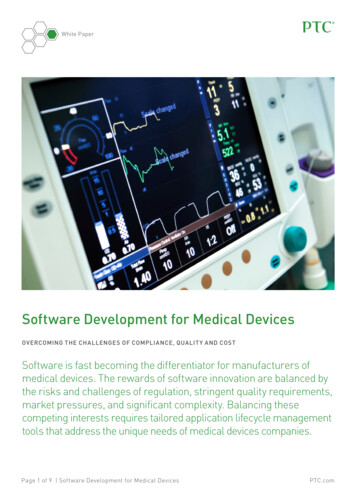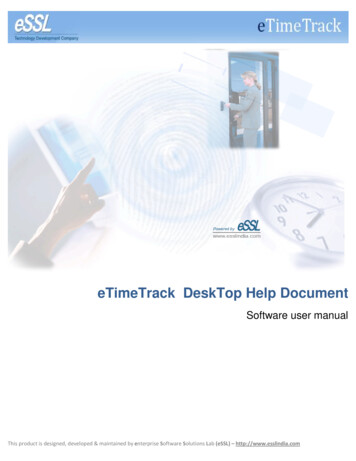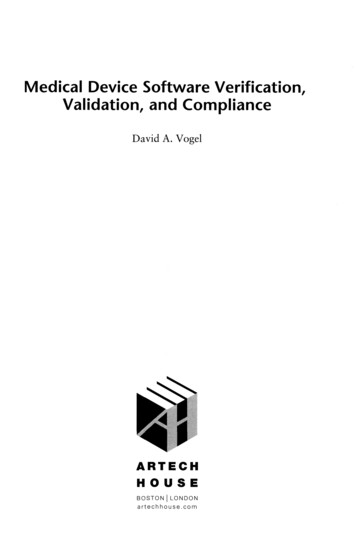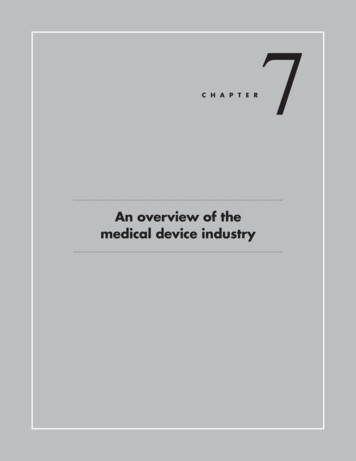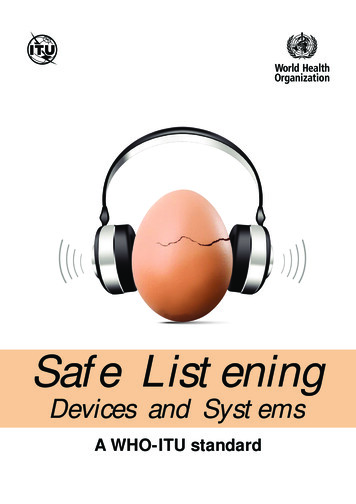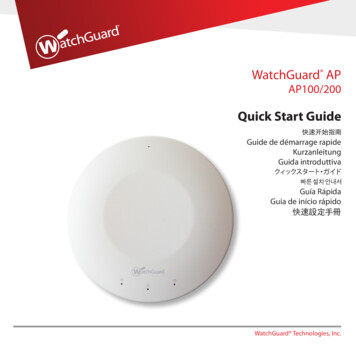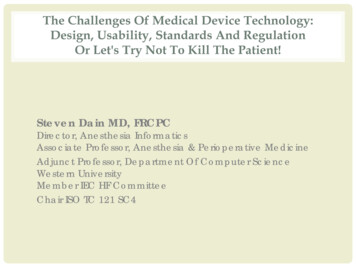
Transcription
The Challenges Of Medical Device Technology:Design, Usability, Standards And RegulationOr Let's Try Not To Kill The Patient!Steven Dain MD, FRCPCDirector, Anesthesia InformaticsAssociate Professor, Anesthesia & Perioperative MedicineAdjunct Professor, Department Of Computer ScienceWestern UniversityMember IEC HF CommitteeChair ISO TC 121 SC4
OBJECTIVES What do you need to know to start designing andbuilding medical devices What are standards and what do I need to knowabout them Usability engineering-application to medicaldevices Some examples of equipment What regulatory hoops do you need to jumpthrough
MEDICAL DEVICES Design and construction is very regulated Needs to be electrically safe within the hostileenvironment of the operating room or ICU May have a direct connection with conductors intothe heart-microshock May have to survive the shock of a defibrillator orelectrocautery machine Needs to be easy to use-prevention and mitigationof errors
IEC 60601IEC 60601-1:2005-Ed.3.0Medical electrical equipment - Part 1:General requirements for basic safetyand essential performance
MEDICAL DEVICES
MEDICAL ELECTRICAL EQUIPMENT Medical device with one or more parts connectedto the patient Connected to Mains
AC CURRENT & THE HEARTWeirich J, Hohnloser S, Antoni H.1983 . Factors determining the susceptibility of the isolatedguinea pig heart to ventricular fibrillation induced by sinusoidal alternating current at frequenciesfrom 1 to 1000 Hz. Basic Res Cardiol. 1983 Nov-Dec;78(6):604-16.
IEC 60601 Family of standard for basic safety and essentialperformance
IEC 60601-1-2 Part 1-2: General requirements for basic safety andessential performance - Collateral standard:Electromagnetic phenomena - Requirements andtests
IEC 60601-1-4 Medical electrical equipment - Part 1-4: Generalrequirements for safety - Collateral standard:Programmable electrical medical systems
IEC 60601-1-6 Medical electrical equipment - Part 1-6: Generalrequirements for safety - Collateral standard:Usability IEC 60601-1-8:2006-Ed.2.0
IEC 60601-1-8 Medical electrical equipment - Part 1-8: Generalrequirements for safety - Collateral standard:General requirements, tests and guidance for alarmsystems in medical electrical equipment andmedical electrical systems
ISO 14971
QUALITY SYSTEMS ISO 13485:2003 specifies requirements for a qualitymanagement system an organization needs to demonstrate its ability toprovide medical devices and related services thatconsistently meet customer requirements andregulatory requirements applicable to medical devices and related services Based ISO 9001
RECOGNIZED STANDARDS Health Canada Website es/md rec stand im norm lsteng.php
PROBLEMS WITH CURRENTDEVICES
PROBLEMS WITH CURRENT DEVICES Artifact Usability Alarms
ARTIFACTS-CAUSES
ARTIFACTS-CAUSES
ARTIFACT-PREVENTION Need for better artifact detection and signalextraction Improvements in biological sensors Better electronic filtering Improved digital signal processing Combining information from multiple sensors Heart rate from ECG, SpO2, arterial lines
CONCLUSIONS Artifacts remain a significant problem for processingand displaying correct clinical information Most current devices still use simple linear filters thatare often ineffective Need for improved methods of artifact prevention,detection and elimination
USABILITY ENGINEERING
USABILITY ENGINEERINGThe application of knowledge about humanbehavior, abilities, limitations, and othercharacteristics to the design of equipment,systems, tasks, jobs, and environments to achieveproductive, safe, comfortable, and effectivehuman use.
KISS PRINCIPLE
HUMAN FACTORSDESIGN PROCESS
KEEP IT SIMPLE &SAFE!
SO EASY
USABILITY MYTHSUsability testing is the same asFunctional Testing.We can't involve users in the designbecause they’ll want to changethe functionality and scope of theproduct.
USABILITY MYTHS The design is finished. We'll handle that problem in thehelp documentation. We'll handle that problem in thetraining.
HUMAN FACTORS DESIGN PROCESS Product Idea Target user and environment Focus Groups
HUMAN FACTORS ENGINEERING Usability goal setting, ergonomics Design and Prototypedevelopment Usability testing Further design and iterative testing
USABILITY TESTING Frequent use scenarios Critical use scenarios Does the equipment do what Iwant, is it easy to learn, easy toremember, easy to use, andintuitive?
HCI DESIGN GOALS Learnability Memorizability Efficiency Errors Satisfaction
ERRORS Design the equipment to minimize errors If an error is made, design equipment for easy andsafe recovery from the error Risk Analysis Process
DEADLY DESIGN ERRORAECL radiation therapy machine Text based operator interface Operator made typing mistake, thought shecorrected it, but machine delivered a lethal dose ofradiation
NUISANCE AND POTENTIAL HAZARDBaxter syringe pump AS50 Must turn off pump and reprogram pump ifpatient’s weight wrongly entered
SATISFACTION Enjoyment of use Want to use equipment vs fear or hating to useequipment
HUMAN EQUIPMENT INTERFACE GUI Design Expected persons to use equipment Expected Environment of use
EXPECTED PERSONS OF USE Age – adults, teens, children, the elderlyHeight and WeightEyesight -- presbyopiaColour blindness –red/greenOther common diseases – diabetes, rheumatoidarthritis
INSULIN PUMP
http://www.medtronicdiabetes.ca/en/paradigm veo.html
EXPECTED PERSONS OF USE Level of Education Technical Knowledge
EXPECTED ENVIRONMENT OF USE Inside/Outside - are
EXPECTED POSITION Sitting Standing Operators –Height/Weight
A Cool Interface is notalways Usable
Usable Cool
Need to design equipment that isso foolproof that it can't bebrought to its knees by awell-intentioned novice.
Thank-youSteven Dainsdain@uwo.ca
ALARM SYSTEMS
PROBLEMS It is estimated that alarm signals annunciate in theoperating room every 4-5 minutes during eachgeneral anesthetic
ALARM STANDARDS60601-1-8 General requirements and guidelines forthe application of alarms in medical electricalequipment
ALARM SYSTEMSNu m b er o f p uls e s i n b ur st1 )P ul se s p aci n g (ts) 2)B e tw e e n 1 s t a n d 2 n d p u l s e sb e tw e e n 2 n d a n d 3 r d p u l s e sb e tw e e n 3 r d a n d 4 t h p u l s e sb e tw e e n 4 t h a n d 5 t h p u l s e sBu r s t s pa ci ng (tb)53x 3)xy 3)y2xxn ot a p pl ica b len ot a p pl ica b le2 s / - 0, 2 sn ot a p pl ica b le
ALARM SYSTEMS Pleasant soundsEasy to identify and readDisable, Mute, Suspend, SilenceLatching or non-latchingAble to disable separate functions
ALARM SYSTEMS One of the largest sources of irritation in the OR andICU’s Anesthesiologists tend to disable alarm systems inthe OR Prompted by poor design of alarm systems inexisting equipment
CURRENT PROBLEMS Loud Annoying, irritating Too many artifacts Recognition of auditory alarm signals Continuous sounds
Current Medical Equipment
Alarm ProcessAlarm conditionwhat alarm and when to annunciateIs the system disabled, silenced or suspended?Alarm signal(auditory,visual, verbal, vibratory)Priority of alarm signal--urgency of response required
Alarm Processlocate area of room or roomlocate equipmentlocate patientread the visual alarm signal to determine source of alarmresponse or awareness
Philosophy of Alarm Design Pleasant non-startling sounds non-continuous not overly loud recognition of device urgency mapping/encoding
LEARNABILITY Is it easy to learn Is there a rapid learning curve-easy to learn vs rapid to use
MEMORIZABILITY Once learned, is the knowledge retained Frequent use Intermittent use
EFFICIENCY Intuitive, minimal number of steps for frequentlyused functions Preferably one menu deep Never more than 3 deep Short-cuts for expert users
The Challenges Of Medical Device Technology: Design, Usability, Standards And Regulation Or Let's Try Not To Kill The Patient! Steven Dain MD, FRCPC





